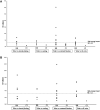Are Observational Studies on Distal Radius Fracture Treatment Robust? An E-value Approach to Analysis
- PMID: 36728049
- PMCID: PMC10194513
- DOI: 10.1097/CORR.0000000000002528
Are Observational Studies on Distal Radius Fracture Treatment Robust? An E-value Approach to Analysis
Abstract
Background: Reported complication frequencies after distal radius fracture (DRF) treatment vary widely in the literature and are based mostly on observational evidence. Whether that evidence is sufficiently robust to use in practice is controversial. The E-value is an innovative sensitivity analysis that quantitates the robustness of observational evidence against unmeasured confounders, whereby a greater E-value usually implies more robust evidence and vice versa; with DRF complications, this approach can help guide readers to a more confident interpretation of the available evidence.
Questions/purposes: In this study, we sought (1) to compare the complication frequencies among different DRF treatment modalities, and (2) to evaluate the robustness of these observational studies using the E-value as an index for unmeasured confounding.
Methods: We searched PubMed, Embase, and SCOPUS for observational studies on the management of DRFs that were published from January 2001 to July 2021 with the last database search performed on July 31, 2021. All articles that compared different DRF treatment modalities with reported complication frequencies were included to accurately capture the quality of the observational studies in research about DRF. Risk ratios (RRs) of the overall complication and major complication risks were calculated for each subgroup comparison: volar plating versus dorsal plating, casting, external fixation, and percutaneous K-wire fixation. The RRs and their corresponding lower limits of the 95% confidence intervals (CIs) were used to derive the E-values. E-values can have a minimum possible value of 1, which signifies that the treatment-outcome association is not strong and can readily be overturned by unmeasured confounders. By contrast, a large E-value means that the observed treatment-outcome association is robust against unmeasured confounders. We averaged RRs and E-values for the effect estimates and lower limits of CIs across studies in each treatment comparison group. We identified 36 comparative observational studies that met the inclusion criteria. Seven studies compared volar with dorsal plating techniques. Volar plating was also compared with casting (eight studies), external fixation (15 studies), and percutaneous K-wire fixation (six studies).
Results: Total and major complication risks did not differ among different DRF treatments. The mean RRs for total and major complications were 1.2 (95% CI 0.4 to 3.9; p = 0.74) and 1.8 (95% CI 0.4 to 11.4; p = 0.52) for the volar versus dorsal plating group; 1.2 (95% CI 0.3 to 11.2; p = 0.87) and 1.5 (95% CI 0.3 to 14.9; p = 0.74) for the volar plating versus casting group; 0.6 (95% CI 0.2 to 2.2; p = 0.33) and 0.8 (95% CI 0.2 to 6.7; p = 0.86) for the volar plating versus external fixation group; and 0.6 (95% CI 0.2 to 2.6; p = 0.47) and 0.7 (95% CI 0.2 to 4.0; p = 0.67) for the volar plating versus K-wire fixation group. The mean E-values for total and major complication frequencies for the between-group comparison ranged from 3.1 to 5.8; these were relatively large in the context of a known complication risk factor, such as high-energy impact (RR 3.2), suggesting a reasonable level of robustness against unmeasured confounding. However, the E-values for lower limits of CIs remained close to 1, which indicates the observed complication frequencies in these studies were likely to have been influenced by unmeasured confounders.
Conclusion: Complication frequencies did not differ among different DRF treatment modalities, but the observed complication frequencies from most comparative observational studies were less robust against potential unmeasured confounders. The E-value method, or another type of sensitivity analysis, should be implemented in observational hand surgery research at the individual-study level to facilitate assessment of robustness against potential unmeasured confounders.
Level of evidence: Level III, therapeutic study.
Copyright © 2023 by the Association of Bone and Joint Surgeons.
Conflict of interest statement
All ICMJE Conflict of Interest Forms for authors and Clinical Orthopaedics and Related Research® editors and board members are on file with the publication and can be viewed on request.
Figures


Comment in
-
CORR Insights®: Are Observational Studies on Distal Radius Fracture Treatment Robust? An E-value Approach to Analysis.Clin Orthop Relat Res. 2023 Jun 1;481(6):1193-1195. doi: 10.1097/CORR.0000000000002553. Epub 2023 Jan 18. Clin Orthop Relat Res. 2023. PMID: 36728043 Free PMC article. No abstract available.
References
-
- Arora R, Gabl M, Gschwentner M, Deml C, Krappinger D, Lutz M. A comparative study of clinical and radiologic outcomes of unstable colles type distal radius fractures in patients older than 70 years: nonoperative treatment versus volar locking plating. J Orthop Trauma. 2009;23:237-242. - PubMed
-
- Bisaccia M, Rinonapoli G, Bisaccia O, et al. Articular fractures of distal radius: comparison of treatment and clinical and radiological outcomes with volar plate versus hoffmann bridging external fixator. EuroMediterranean Biomedical Journal. 2017;12:23-28.
-
- Chan Y-H, Foo T-L, Yeo C-J, Chew WY-C. Comparison between cast immobilization versus volar locking plate fixation of distal radius fractures in active elderly patients, the Asian perspective. Hand Surg. 2014;19:19-23. - PubMed
Publication types
MeSH terms
LinkOut - more resources
Full Text Sources
Medical
Research Materials
Miscellaneous

